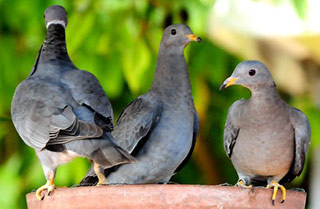Die-offs of band-tailed pigeons connected to newly discovered parasite

Researchers at UC Davis and the California Department of Fish and Wildlife have identified trichomonosis as a key factor in winter die-offs and population decline of bandtailed pidgeons, a native migratory game bird. (Dianne Ricky/courtesy photo)
Scientists were able to implicate this new parasite, along with the ancient parasite Trichomonas gallinae, in the recent deaths of thousands of Pacific Coast band-tailed pigeons. The die-offs occurred during multiple epidemics in California’s Central Coast and Sierra Nevada mountain ranges. Scientists named the new pathogen Trichomonas stableri.
Avian trichomonosis is an emerging and potentially fatal disease that creates severe lesions that can block the esophagus, ultimately preventing the bird from eating or drinking, or the trachea, leading to suffocation. The disease may date back to when dinosaurs roamed the earth, as lesions indicative of trichomonosis were found recently in T-Rex skeletons. The disease may also have contributed to the decline of the passenger pigeon, whose extinction occurred exactly 100 years ago.
Epidemics of the disease can result in the death of thousands of birds in a short amount of time. An outbreak in Carmel Valley killed an estimated 43,000 birds in 2007.
“The same parasite species that killed band-tailed pigeons during the outbreaks were also killing the birds when there weren’t outbreaks,” said lead author Yvette Girard, a postdoctoral scholar with the Wildlife Health Center in the UC Davis School of Veterinary Medicine at the time of the studies. “This indicates there may be other factors at play in the die-offs.”
“We are now investigating what triggers these die-offs, which may be caused by the congregation of infected and vulnerable birds during certain environmental conditions, or even spillover from another nearby species,” said principal investigator Christine Johnson, a professor with the UC Davis Wildlife Health Center.
Between winter 2011 and spring 2012, there were eight mortality events — defined as more than five dead birds found in the same geographic area during the same time frame. The study said trichomonosis was confirmed in 96 percent of dead, sick or dying birds examined at seven of the mortality events. This disease was also found in:
- 36 percent of band-tailed pigeons at wildlife rehabilitation centers
- 11 percent of hunter-killed band-tailed pigeons
- 4 percent of the birds caught live and released
“What makes this disease more troublesome for band-tailed pigeons is their low reproductive rate — about one chick per year — and also that these events are occurring in the wintertime,” said co-author Krysta Rogers, an environmental scientist with the California Department of Fish and Wildlife. “That means almost all the birds we’re losing during events are adult birds. They’re being killed before they have the ability to reproduce in the spring.”
Mortality events in band-tailed pigeons have been reported in California at least since 1945, but have increased during the last decade, with outbreaks reported in six of the last 10 years.
“Going into the study, we expected to find a single, highly virulent species of Trichomonas in birds sampled at outbreaks,” Girard said. “Having two species killing birds at these large-scale mortality events is surprising.”
Necropsies of the birds were conducted at the California Animal Health and Food Safety Laboratory at UC Davis and the Wildlife Investigations Laboratory at the California Department of Fish and Wildlife.
Both studies were funded by the California Department of Fish and Wildlife and the U.S. Fish and Wildlife Service.
The study naming the new species of parasite is published in the journal International Journal for Parasitology: Parasites and Wildlife. The study that explains how trichomonosis is affecting the band-tailed pigeon is published in the journal Infection, Genetics and Evolution.
UC Davis is a global community of individuals united to better humanity and our natural world while seeking solutions to some of our most pressing challenges. Located near the California state capital, UC Davis has more than 34,000 students, and the full-time equivalent of 4,100 faculty and other academics and 17,400 staff. The campus has an annual research budget of over $750 million, a comprehensive health system and about two dozen specialized research centers. The university offers interdisciplinary graduate study and 99 undergraduate majors in four colleges and six professional schools.
- Download photos of band-tailed pigeons.
- Read the naming study.
- Read the broader study.
- Related story: “California's blackbird in sharp decline.”
- Related story: “Failure to launch: California brown pelicans' breeding rates dismal.”
- Yvette Girard, UC Davis Wildlife Health Center, yagirard@gmail.com (To arrange a phone interview, please contact Kat Kerlin, below.)
- Krysta Rogers, California Department of Fish and Wildlife, (916) 358-1662, Krysta.Rogers@wildlife.ca.gov
- Kat Kerlin, UC Davis News Service, (530) 752-7704, kekerlin@ucdavis.edu
Media Contact
All latest news from the category: Ecology, The Environment and Conservation
This complex theme deals primarily with interactions between organisms and the environmental factors that impact them, but to a greater extent between individual inanimate environmental factors.
innovations-report offers informative reports and articles on topics such as climate protection, landscape conservation, ecological systems, wildlife and nature parks and ecosystem efficiency and balance.
Newest articles

Long-sought structure of powerful anticancer natural product
…solved by integrated approach. A collaborative effort by the research groups of Professor Haruhiko Fuwa from Chuo University and Professor Masashi Tsuda from Kochi University has culminated in the structure…

Making a difference: Efficient water harvesting from air possible
Copolymer solution uses water-loving differential to induce desorption at lower temperatures. Harvesting water from the air and decreasing humidity are crucial to realizing a more comfortable life for humanity. Water-adsorption…

In major materials breakthrough
UVA team solves a nearly 200-year-old challenge in polymers. UVA researchers defy materials science rules with molecules that release stored length to decouple stiffness and stretchability. Researchers at the University…



